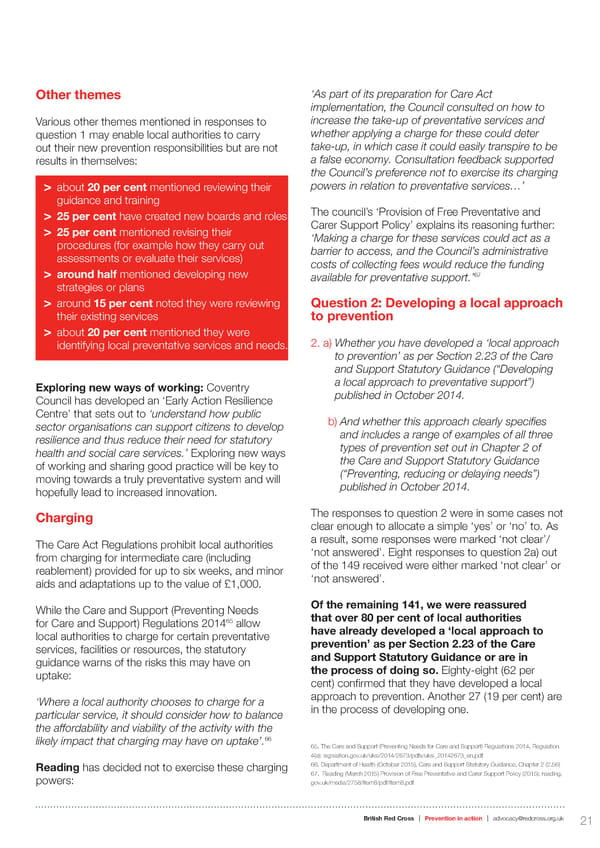Other themes ‘As part of its preparation for Care Act implementation, the Council consulted on how to Various other themes mentioned in responses to increase the take-up of preventative services and question 1 may enable local authorities to carry whether applying a charge for these could deter out their new prevention responsibilities but are not take-up, in which case it could easily transpire to be results in themselves: a false economy. Consultation feedback supported the Council’s preference not to exercise its charging > about 20 per cent mentioned reviewing their powers in relation to preventative services…’ guidance and training > 25 per cent have created new boards and roles The council’s ‘Provision of Free Preventative and > 25 per cent mentioned revising their Carer Support Policy’ explains its reasoning further: procedures (for example how they carry out ‘Making a charge for these services could act as a assessments or evaluate their services) barrier to access, and the Council’s administrative costs of collecting fees would reduce the funding > around half mentioned developing new 67 available for preventative support.’ strategies or plans > around 15 per cent noted they were reviewing Question 2: Developing a local approach their existing services to prevention > about 20 per cent mentioned they were identifying local preventative services and needs. 2. a) Whether you have developed a ‘local approach to prevention’ as per Section 2.23 of the Care and Support Statutory Guidance (“Developing Exploring new ways of working: Coventry a local approach to preventative support”) Council has developed an ‘Early Action Resilience published in October 2014. Centre’ that sets out to ‘understand how public b) And whether this approach clearly specifies sector organisations can support citizens to develop and includes a range of examples of all three resilience and thus reduce their need for statutory types of prevention set out in Chapter 2 of health and social care services.’ Exploring new ways the Care and Support Statutory Guidance of working and sharing good practice will be key to (“Preventing, reducing or delaying needs”) moving towards a truly preventative system and will published in October 2014. hopefully lead to increased innovation. Charging The responses to question 2 were in some cases not clear enough to allocate a simple ‘yes’ or ‘no’ to. As The Care Act Regulations prohibit local authorities a result, some responses were marked ‘not clear’/ from charging for intermediate care (including ‘not answered’. Eight responses to question 2a) out reablement) provided for up to six weeks, and minor of the 149 received were either marked ‘not clear’ or aids and adaptations up to the value of £1,000. ‘not answered’. While the Care and Support (Preventing Needs Of the remaining 141, we were reassured 65 that over 80 per cent of local authorities for Care and Support) Regulations 2014 allow have already developed a ‘local approach to local authorities to charge for certain preventative prevention’ as per Section 2.23 of the Care services, facilities or resources, the statutory and Support Statutory Guidance or are in guidance warns of the risks this may have on the process of doing so. Eighty-eight (62 per uptake: cent) confirmed that they have developed a local ‘Where a local authority chooses to charge for a approach to prevention. Another 27 (19 per cent) are particular service, it should consider how to balance in the process of developing one. the affordability and viability of the activity with the 66 likely impact that charging may have on uptake’. 65. The Care and Support (Preventing Needs for Care and Support) Regulations 2014, Regulation 4(a): legislation.gov.uk/uksi/2014/2673/pdfs/uksi_20142673_en.pdf Reading has decided not to exercise these charging 66. Department of Health (October 2015), Care and Support Statutory Guidance, Chapter 2 (2.56) powers: 67. Reading (March 2015) Provision of Free Preventative and Carer Support Policy (2015): reading. gov.uk/media/2758/Item8/pdf/Item8.pdf British Red Cross Prevention in action [email protected] l l 21
 Prevention in Action 2016 Page 20 Page 22
Prevention in Action 2016 Page 20 Page 22